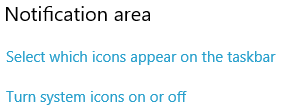Starting/closing
Starting, Reopening, and Closing OneCommander
By default OneCommander continues to run in background once started (like Explorer - when you close Explorer window, explorer.exe still runs). This makes it start faster the next time. OneCommander is built on .NET which compiles code at the time it is run, and it will never break any startup speed records, and this way it takes performance hit only on start. If you enable Autorstart with Windows (Settings>Advanced) and let it run in the background, you will not need to worry about those 3 seconds.
To re-open OneCommander when it is running in the background:
- Double-click on the OneCommander icon in the System Tray or Notification Area (the area at the right-hand end of the Windows Taskbar holding things like the Windows volume control; see below if you can't see the OneCommander icon here).
- Right-click on the OneCommander icon in the System Tray/Notification Area and select "Show window".
- Press Win+Alt+E (set to be close to Win+E Explorer hotkey, but can be changed in settings)
To fully shut OneCommander down, right-click on the OneCommander icon in the System Tray/Notification Area and select "Exit",
or Ctrl+Click WindowClose at the top right of the Main Window.
at the top right of the Main Window.
Restarting as Administrator
To restart OneCommander as Administrator, press Ctrl+Shift+F12. Running as Administrator is not recommended, as drag&drop from other applications won't work (windows limitation), files created in this mode may have different owner and permissions, some context menu items won't be available...
Run as a different user
In multiuser environment, you may want to run OC in another user's context.
Right-click OC icon in system tray and click Run as different user [PRO].
Starting from Command Line
See here.
If the OneCommander icon isn't visible in the System Tray/Notification Area:
Quick way: At the top of the System Tray/Notification area, click on the arrow: 
That will reveal all System Tray/Notification Area icons. Drag the OneCommander icon to the area with other icons such as volume control.
Slow way: Right-click in an unused part of the Windows Taskbar and select "Taskbar settings". Scroll down the right-hand Settings window to the Notification area:
Click on "Select which icons appear on the taskbar", scroll down to OneCommander, and turn it on.